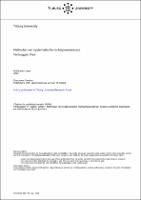Methoden van systematische rechtspraakanalyse
Tussen juridische dogmatiek en data science
| dc.contributor.editor | Verbruggen, Paul | |
| dc.date.accessioned | 2022-08-03T12:18:51Z | |
| dc.date.available | 2022-08-03T12:18:51Z | |
| dc.date.issued | 2021 | |
| dc.identifier | OCN: 1262581221 | |
| dc.identifier.uri | https://library.oapen.org/handle/20.500.12657/57756 | |
| dc.description.abstract | Practitioner lawyers and legal scientists pay a lot of attention to providing insight into developments and patterns in the judiciary. However, with the question of exactly how they arrive at their insights and account for them, they are entering less familiar territory. Important questions they ask themselves are: How do I collect case law? Which statements do I select or not select for analysis? How do I expose a pattern? How reliable are the insights found? What exactly is their relevance and meaning? And how can software, artificial intelligence or other data science techniques help with this? Methods of systematic case law analysis addresses these and other questions that arise when conducting large-scale case law research. With the increasing digital availability of justice, this research is increasingly attractive. At the same time, this development justifies increased attention to the methodological justification of case law analysis. In this book, the authors outline some important methodological lessons for doing this type of legal research based on their experiences with systematic case law analysis. This makes the book important for students, PhD students and more experienced lawyers in science and practice. | en_US |
| dc.language | Dutch | en_US |
| dc.subject.classification | thema EDItEUR::L Law::LN Laws of specific jurisdictions and specific areas of law::LNA Legal systems: general | en_US |
| dc.subject.other | methoden van rechtswetenschap; rechtspraakanalyse; jurisprudentieanalyse; kwalitatieve analyse; kwantitatieve analyse; data science; artificial intelligence; AI; Legal analytics; judiciary | en_US |
| dc.title | Methoden van systematische rechtspraakanalyse | en_US |
| dc.title.alternative | Tussen juridische dogmatiek en data science | en_US |
| dc.type | book | |
| oapen.abstract.otherlanguage | Praktijkjuristen en rechtswetenschappers besteden veel aandacht aan het inzichtelijk maken van ontwikkelingen en patronen in rechtspraak. Met de vraag hoe zij precies tot hun inzichten komen en daarover verantwoording afleggen, begeven zij zich echter op minder bekend terrein. Belangrijke vragen die zij zich stellen zijn: Hoe verzamel ik rechtspraak? Welke uitspraken selecteer ik wel of niet voor analyse? Hoe leg ik een patroon bloot? Hoe betrouwbaar zijn de gevonden inzichten? Wat is precies hun relevantie en betekenis? En hoe kunnen software, kunstmatige intelligentie of andere data science-technieken hierbij helpen? Methoden van systematische rechtspraakanalyse behandelt deze en andere vragen die spelen bij het doen van grootschalig jurisprudentieonderzoek. Dat onderzoek wordt met de toenemende digitale beschikbaarheid van rechtspraak steeds aantrekkelijker. Tegelijkertijd rechtvaardigt die ontwikkeling een vergrote aandacht voor de methodologische verantwoording van rechtspraakanalyse. De auteurs schetsen in dit boek op basis van hun ervaringen met systematische rechtspraakanalyse enkele belangrijke methodologische lessen voor het doen van dit type juridisch onderzoek. Daarmee is het boek van belang voor studenten, promovendi en meer ervaren juristen in de wetenschap en praktijk. | en_US |
| oapen.relation.isPublishedBy | e4313eaf-e0a4-41fe-b4e4-4b03a208deb9 | en_US |
| oapen.relation.isFundedBy | da087c60-8432-4f58-b2dd-747fc1a60025 | en_US |
| oapen.relation.isbn | 9789462909755 | en_US |
| oapen.collection | Dutch Research Council (NWO) | en_US |
| oapen.pages | 215 | en_US |
| oapen.grant.number | 451-16-011 |

